Business Environment: Hemel Hempstead
VerifiedAdded on 2021/01/02
|12
|3848
|93
AI Summary
Contribute Materials
Your contribution can guide someone’s learning journey. Share your
documents today.
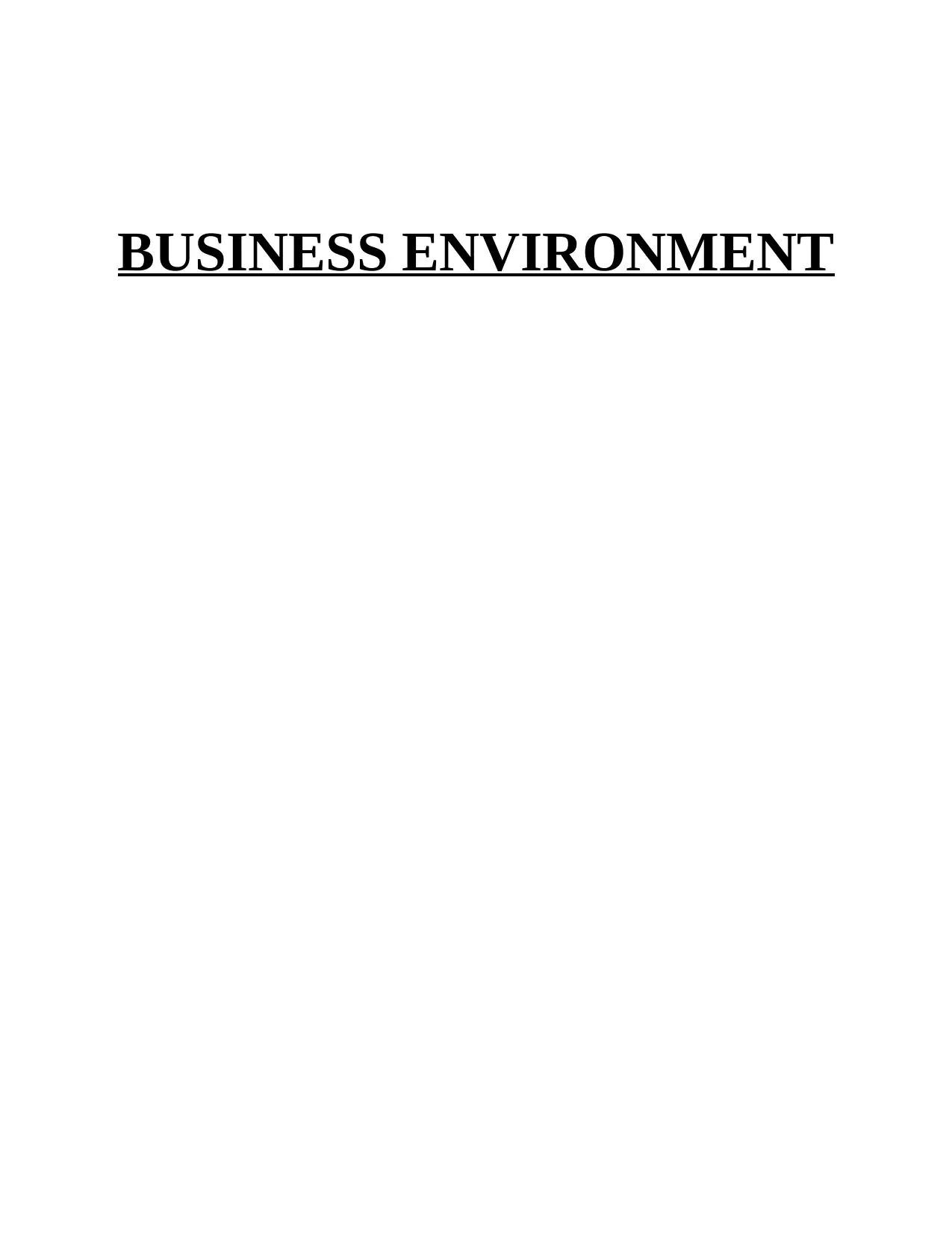
BUSINESS ENVIRONMENT
Secure Best Marks with AI Grader
Need help grading? Try our AI Grader for instant feedback on your assignments.
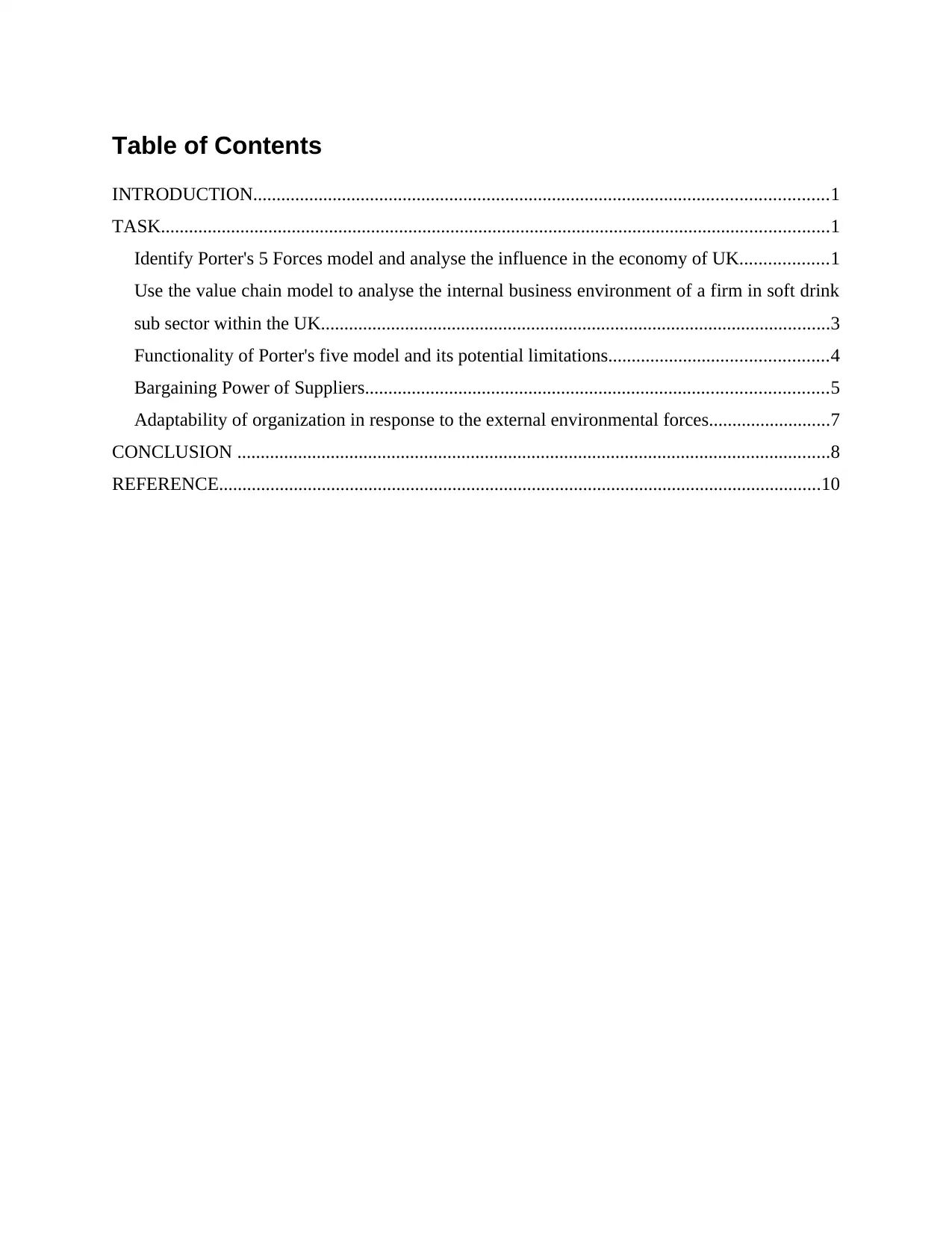
Table of Contents
INTRODUCTION...........................................................................................................................1
TASK...............................................................................................................................................1
Identify Porter's 5 Forces model and analyse the influence in the economy of UK...................1
Use the value chain model to analyse the internal business environment of a firm in soft drink
sub sector within the UK.............................................................................................................3
Functionality of Porter's five model and its potential limitations...............................................4
Bargaining Power of Suppliers...................................................................................................5
Adaptability of organization in response to the external environmental forces..........................7
CONCLUSION ...............................................................................................................................8
REFERENCE.................................................................................................................................10
INTRODUCTION...........................................................................................................................1
TASK...............................................................................................................................................1
Identify Porter's 5 Forces model and analyse the influence in the economy of UK...................1
Use the value chain model to analyse the internal business environment of a firm in soft drink
sub sector within the UK.............................................................................................................3
Functionality of Porter's five model and its potential limitations...............................................4
Bargaining Power of Suppliers...................................................................................................5
Adaptability of organization in response to the external environmental forces..........................7
CONCLUSION ...............................................................................................................................8
REFERENCE.................................................................................................................................10
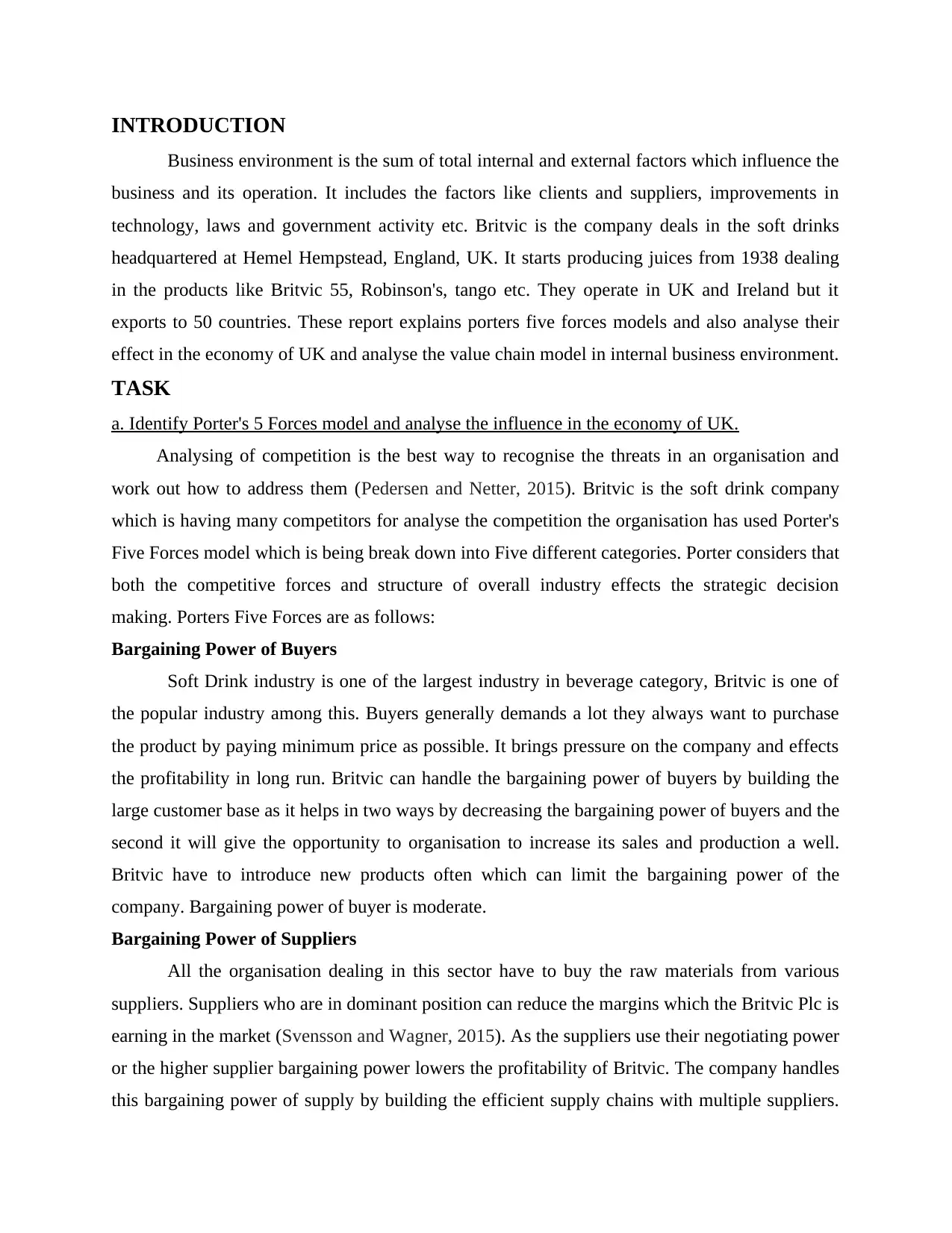
INTRODUCTION
Business environment is the sum of total internal and external factors which influence the
business and its operation. It includes the factors like clients and suppliers, improvements in
technology, laws and government activity etc. Britvic is the company deals in the soft drinks
headquartered at Hemel Hempstead, England, UK. It starts producing juices from 1938 dealing
in the products like Britvic 55, Robinson's, tango etc. They operate in UK and Ireland but it
exports to 50 countries. These report explains porters five forces models and also analyse their
effect in the economy of UK and analyse the value chain model in internal business environment.
TASK
a. Identify Porter's 5 Forces model and analyse the influence in the economy of UK.
Analysing of competition is the best way to recognise the threats in an organisation and
work out how to address them (Pedersen and Netter, 2015). Britvic is the soft drink company
which is having many competitors for analyse the competition the organisation has used Porter's
Five Forces model which is being break down into Five different categories. Porter considers that
both the competitive forces and structure of overall industry effects the strategic decision
making. Porters Five Forces are as follows:
Bargaining Power of Buyers
Soft Drink industry is one of the largest industry in beverage category, Britvic is one of
the popular industry among this. Buyers generally demands a lot they always want to purchase
the product by paying minimum price as possible. It brings pressure on the company and effects
the profitability in long run. Britvic can handle the bargaining power of buyers by building the
large customer base as it helps in two ways by decreasing the bargaining power of buyers and the
second it will give the opportunity to organisation to increase its sales and production a well.
Britvic have to introduce new products often which can limit the bargaining power of the
company. Bargaining power of buyer is moderate.
Bargaining Power of Suppliers
All the organisation dealing in this sector have to buy the raw materials from various
suppliers. Suppliers who are in dominant position can reduce the margins which the Britvic Plc is
earning in the market (Svensson and Wagner, 2015). As the suppliers use their negotiating power
or the higher supplier bargaining power lowers the profitability of Britvic. The company handles
this bargaining power of supply by building the efficient supply chains with multiple suppliers.
Business environment is the sum of total internal and external factors which influence the
business and its operation. It includes the factors like clients and suppliers, improvements in
technology, laws and government activity etc. Britvic is the company deals in the soft drinks
headquartered at Hemel Hempstead, England, UK. It starts producing juices from 1938 dealing
in the products like Britvic 55, Robinson's, tango etc. They operate in UK and Ireland but it
exports to 50 countries. These report explains porters five forces models and also analyse their
effect in the economy of UK and analyse the value chain model in internal business environment.
TASK
a. Identify Porter's 5 Forces model and analyse the influence in the economy of UK.
Analysing of competition is the best way to recognise the threats in an organisation and
work out how to address them (Pedersen and Netter, 2015). Britvic is the soft drink company
which is having many competitors for analyse the competition the organisation has used Porter's
Five Forces model which is being break down into Five different categories. Porter considers that
both the competitive forces and structure of overall industry effects the strategic decision
making. Porters Five Forces are as follows:
Bargaining Power of Buyers
Soft Drink industry is one of the largest industry in beverage category, Britvic is one of
the popular industry among this. Buyers generally demands a lot they always want to purchase
the product by paying minimum price as possible. It brings pressure on the company and effects
the profitability in long run. Britvic can handle the bargaining power of buyers by building the
large customer base as it helps in two ways by decreasing the bargaining power of buyers and the
second it will give the opportunity to organisation to increase its sales and production a well.
Britvic have to introduce new products often which can limit the bargaining power of the
company. Bargaining power of buyer is moderate.
Bargaining Power of Suppliers
All the organisation dealing in this sector have to buy the raw materials from various
suppliers. Suppliers who are in dominant position can reduce the margins which the Britvic Plc is
earning in the market (Svensson and Wagner, 2015). As the suppliers use their negotiating power
or the higher supplier bargaining power lowers the profitability of Britvic. The company handles
this bargaining power of supply by building the efficient supply chains with multiple suppliers.

They always have the substitute for the raw materials they used so if the prices of raw material
rise than the company can shift to another supplier. Britvic can learn the lesson from wal-mart
and Nike that these companies depends on third party and their business depends on them.
Bargaining power of supplier is high.
Threat of New Entrants
Threat of new entrants is low in Britvic. At the same innovation in new products and
services retain the existing customers by giving the reason to buy their products at the same they
also attract the new customers. Build the economies of scale so it can lower the fixed cost per
unit. Company can increase its capacity and spending money on it R&D. Even the new entrants
are less likely to enter into dynamic industry as there are already have the established players like
Britvic which defines their standards.
Threat of Substitutes
There are many kinds of drink products in the market is there which are substitute to each
other like Pepsi and coco cola, to eliminate this factor Britvic needs to be more service oriented
rather than just product oriented and to understand the core need of the customer and their
preferences (Pereira-Moliner and et.al.,2015). The organisation also increases the switching cost
for the customers.
Rivalry among Existing Players
As the rivalry in this industry among the existing players is very high and it will decrease
the prices and also impacts on the overall profitability of this sector. Britvic operates in the very
competitive food and beverages where they are having many rivalries. So the Britvic has built a
sustainable differentiation by building the scale and also done the collaboration with the
competitors to increase the size of market. But there are so many brands which have failed to
reach the success that is having the Britvic.
b. Use the value chain model to analyse the internal business environment of a firm in soft drink
sub sector within the UK.
Value chain is a set of activity which the organisation performs while operating the
specific industry in order to deliver a valuable product or service for the market. This analysis is
rise than the company can shift to another supplier. Britvic can learn the lesson from wal-mart
and Nike that these companies depends on third party and their business depends on them.
Bargaining power of supplier is high.
Threat of New Entrants
Threat of new entrants is low in Britvic. At the same innovation in new products and
services retain the existing customers by giving the reason to buy their products at the same they
also attract the new customers. Build the economies of scale so it can lower the fixed cost per
unit. Company can increase its capacity and spending money on it R&D. Even the new entrants
are less likely to enter into dynamic industry as there are already have the established players like
Britvic which defines their standards.
Threat of Substitutes
There are many kinds of drink products in the market is there which are substitute to each
other like Pepsi and coco cola, to eliminate this factor Britvic needs to be more service oriented
rather than just product oriented and to understand the core need of the customer and their
preferences (Pereira-Moliner and et.al.,2015). The organisation also increases the switching cost
for the customers.
Rivalry among Existing Players
As the rivalry in this industry among the existing players is very high and it will decrease
the prices and also impacts on the overall profitability of this sector. Britvic operates in the very
competitive food and beverages where they are having many rivalries. So the Britvic has built a
sustainable differentiation by building the scale and also done the collaboration with the
competitors to increase the size of market. But there are so many brands which have failed to
reach the success that is having the Britvic.
b. Use the value chain model to analyse the internal business environment of a firm in soft drink
sub sector within the UK.
Value chain is a set of activity which the organisation performs while operating the
specific industry in order to deliver a valuable product or service for the market. This analysis is
Secure Best Marks with AI Grader
Need help grading? Try our AI Grader for instant feedback on your assignments.
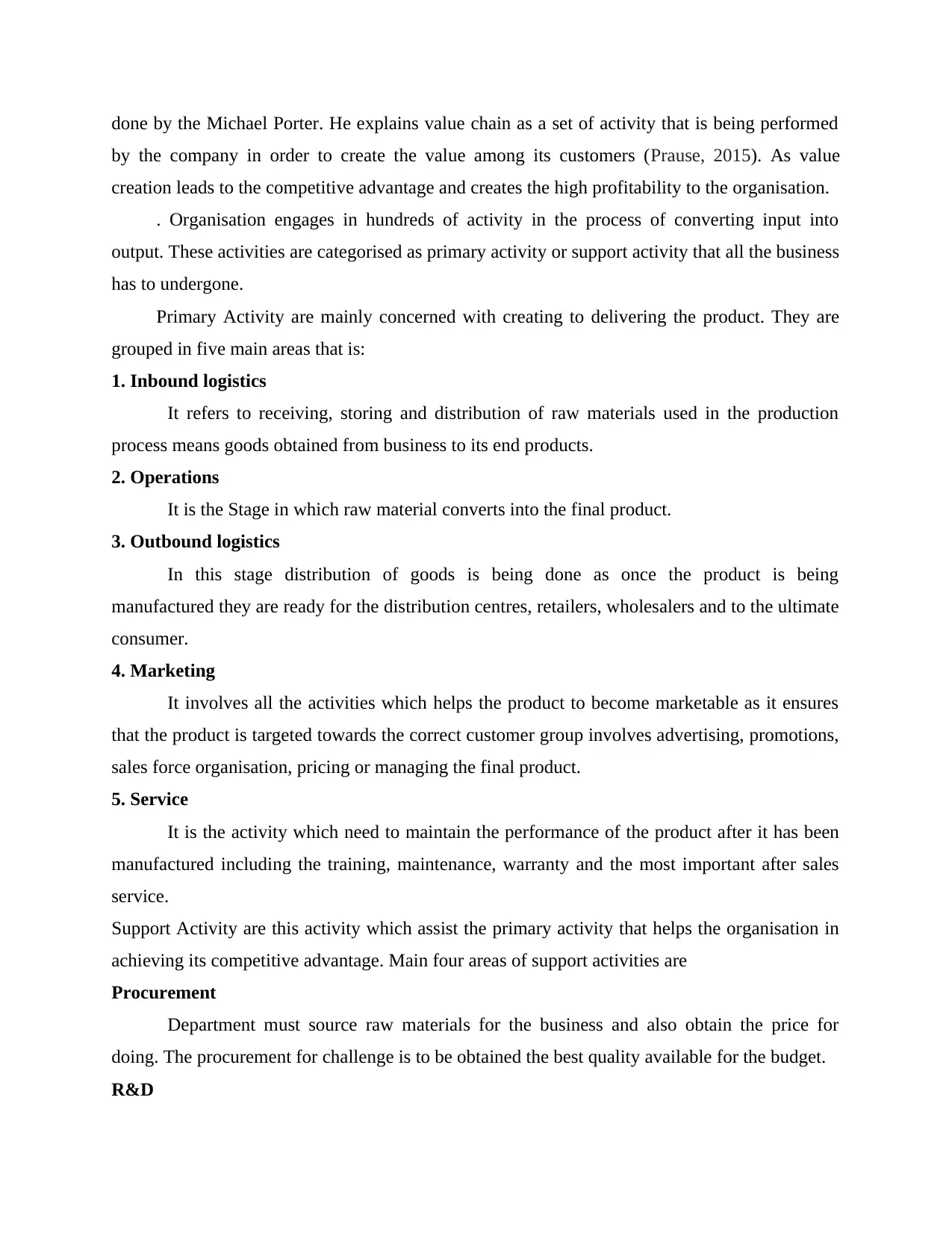
done by the Michael Porter. He explains value chain as a set of activity that is being performed
by the company in order to create the value among its customers (Prause, 2015). As value
creation leads to the competitive advantage and creates the high profitability to the organisation.
. Organisation engages in hundreds of activity in the process of converting input into
output. These activities are categorised as primary activity or support activity that all the business
has to undergone.
Primary Activity are mainly concerned with creating to delivering the product. They are
grouped in five main areas that is:
1. Inbound logistics
It refers to receiving, storing and distribution of raw materials used in the production
process means goods obtained from business to its end products.
2. Operations
It is the Stage in which raw material converts into the final product.
3. Outbound logistics
In this stage distribution of goods is being done as once the product is being
manufactured they are ready for the distribution centres, retailers, wholesalers and to the ultimate
consumer.
4. Marketing
It involves all the activities which helps the product to become marketable as it ensures
that the product is targeted towards the correct customer group involves advertising, promotions,
sales force organisation, pricing or managing the final product.
5. Service
It is the activity which need to maintain the performance of the product after it has been
manufactured including the training, maintenance, warranty and the most important after sales
service.
Support Activity are this activity which assist the primary activity that helps the organisation in
achieving its competitive advantage. Main four areas of support activities are
Procurement
Department must source raw materials for the business and also obtain the price for
doing. The procurement for challenge is to be obtained the best quality available for the budget.
R&D
by the company in order to create the value among its customers (Prause, 2015). As value
creation leads to the competitive advantage and creates the high profitability to the organisation.
. Organisation engages in hundreds of activity in the process of converting input into
output. These activities are categorised as primary activity or support activity that all the business
has to undergone.
Primary Activity are mainly concerned with creating to delivering the product. They are
grouped in five main areas that is:
1. Inbound logistics
It refers to receiving, storing and distribution of raw materials used in the production
process means goods obtained from business to its end products.
2. Operations
It is the Stage in which raw material converts into the final product.
3. Outbound logistics
In this stage distribution of goods is being done as once the product is being
manufactured they are ready for the distribution centres, retailers, wholesalers and to the ultimate
consumer.
4. Marketing
It involves all the activities which helps the product to become marketable as it ensures
that the product is targeted towards the correct customer group involves advertising, promotions,
sales force organisation, pricing or managing the final product.
5. Service
It is the activity which need to maintain the performance of the product after it has been
manufactured including the training, maintenance, warranty and the most important after sales
service.
Support Activity are this activity which assist the primary activity that helps the organisation in
achieving its competitive advantage. Main four areas of support activities are
Procurement
Department must source raw materials for the business and also obtain the price for
doing. The procurement for challenge is to be obtained the best quality available for the budget.
R&D
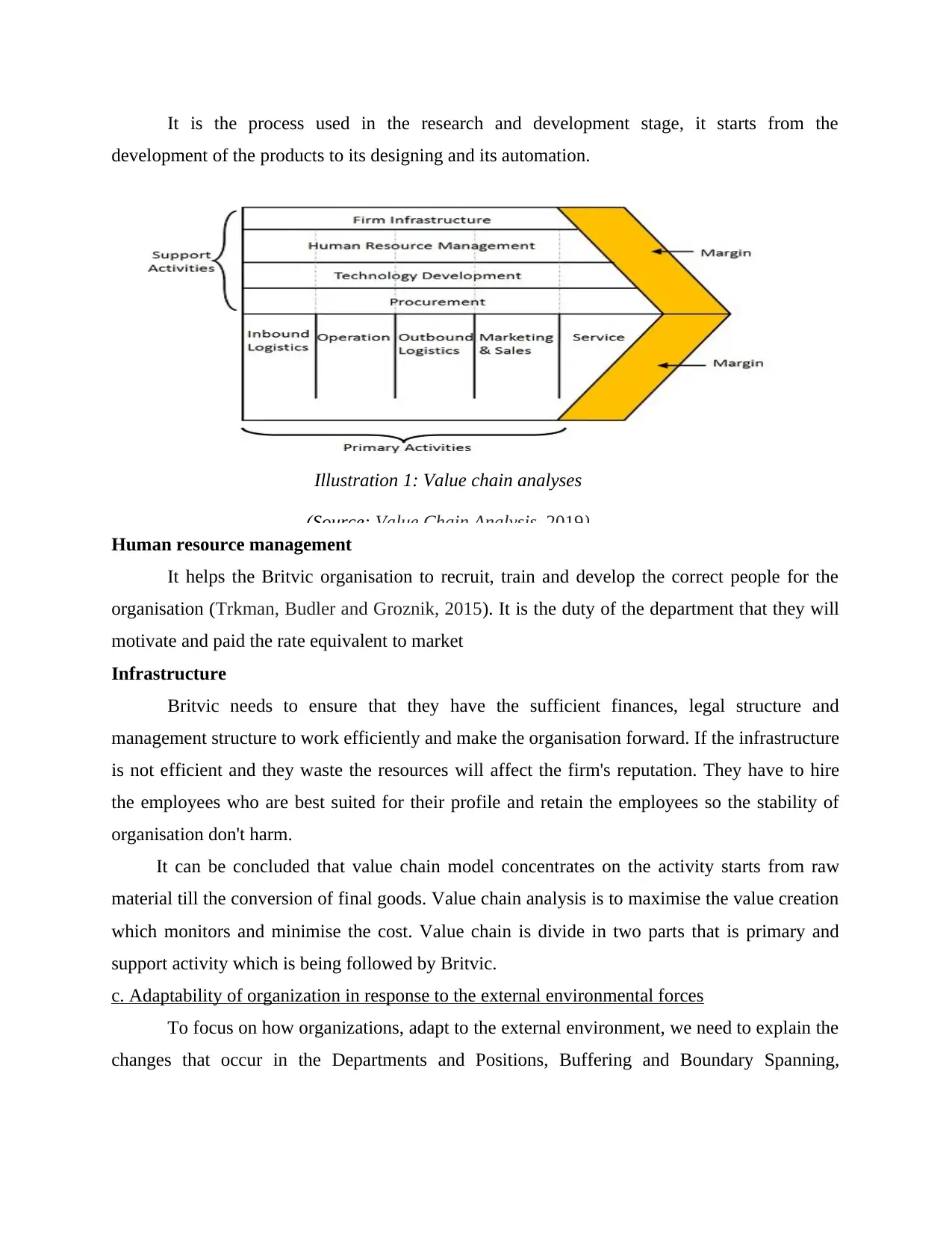
It is the process used in the research and development stage, it starts from the
development of the products to its designing and its automation.
Illustration 1: Value chain analyses
(Source: Value Chain Analysis, 2019)
Human resource management
It helps the Britvic organisation to recruit, train and develop the correct people for the
organisation (Trkman, Budler and Groznik, 2015). It is the duty of the department that they will
motivate and paid the rate equivalent to market
Infrastructure
Britvic needs to ensure that they have the sufficient finances, legal structure and
management structure to work efficiently and make the organisation forward. If the infrastructure
is not efficient and they waste the resources will affect the firm's reputation. They have to hire
the employees who are best suited for their profile and retain the employees so the stability of
organisation don't harm.
It can be concluded that value chain model concentrates on the activity starts from raw
material till the conversion of final goods. Value chain analysis is to maximise the value creation
which monitors and minimise the cost. Value chain is divide in two parts that is primary and
support activity which is being followed by Britvic.
c. Adaptability of organization in response to the external environmental forces
To focus on how organizations, adapt to the external environment, we need to explain the
changes that occur in the Departments and Positions, Buffering and Boundary Spanning,
development of the products to its designing and its automation.
Illustration 1: Value chain analyses
(Source: Value Chain Analysis, 2019)
Human resource management
It helps the Britvic organisation to recruit, train and develop the correct people for the
organisation (Trkman, Budler and Groznik, 2015). It is the duty of the department that they will
motivate and paid the rate equivalent to market
Infrastructure
Britvic needs to ensure that they have the sufficient finances, legal structure and
management structure to work efficiently and make the organisation forward. If the infrastructure
is not efficient and they waste the resources will affect the firm's reputation. They have to hire
the employees who are best suited for their profile and retain the employees so the stability of
organisation don't harm.
It can be concluded that value chain model concentrates on the activity starts from raw
material till the conversion of final goods. Value chain analysis is to maximise the value creation
which monitors and minimise the cost. Value chain is divide in two parts that is primary and
support activity which is being followed by Britvic.
c. Adaptability of organization in response to the external environmental forces
To focus on how organizations, adapt to the external environment, we need to explain the
changes that occur in the Departments and Positions, Buffering and Boundary Spanning,
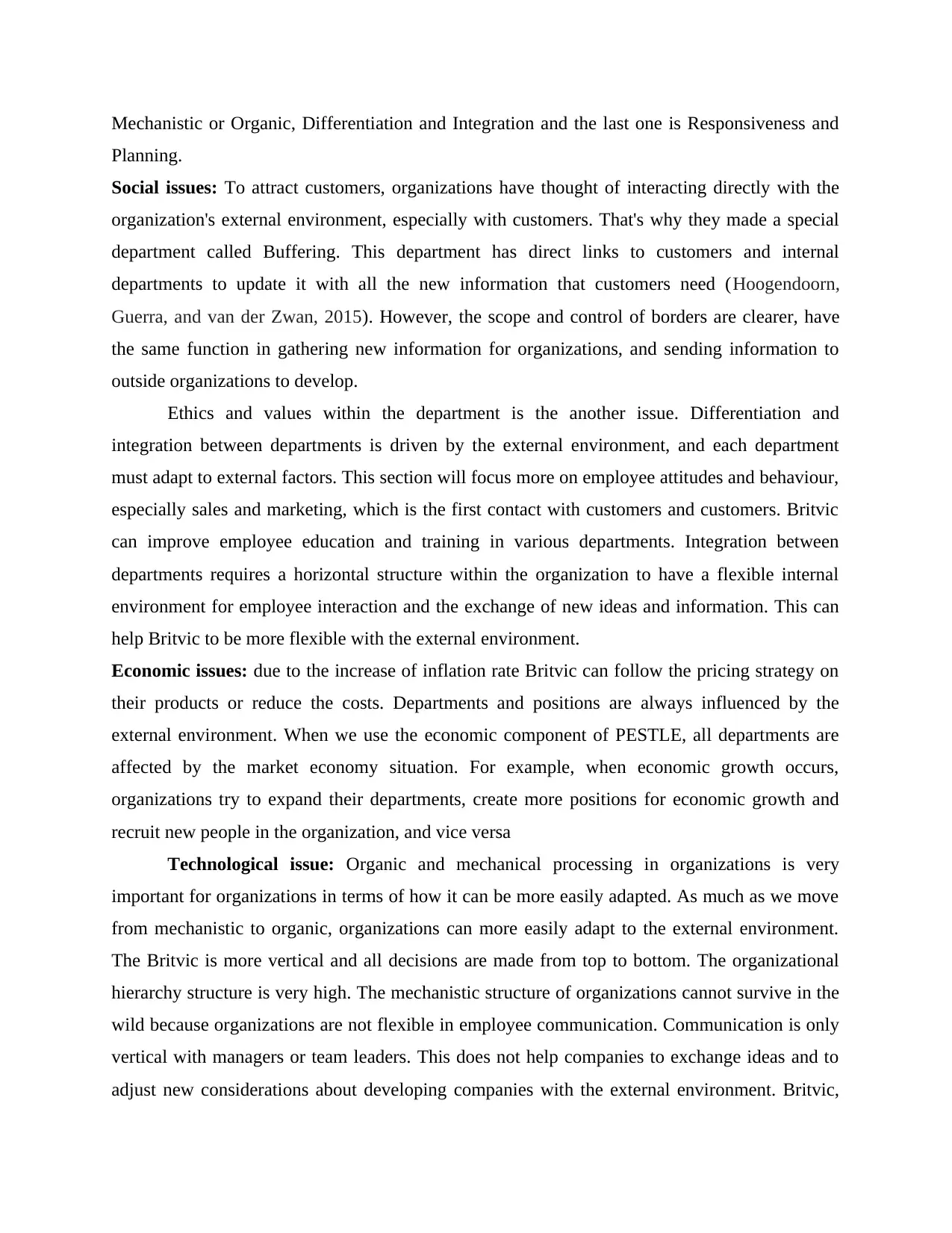
Mechanistic or Organic, Differentiation and Integration and the last one is Responsiveness and
Planning.
Social issues: To attract customers, organizations have thought of interacting directly with the
organization's external environment, especially with customers. That's why they made a special
department called Buffering. This department has direct links to customers and internal
departments to update it with all the new information that customers need (Hoogendoorn,
Guerra, and van der Zwan, 2015). However, the scope and control of borders are clearer, have
the same function in gathering new information for organizations, and sending information to
outside organizations to develop.
Ethics and values within the department is the another issue. Differentiation and
integration between departments is driven by the external environment, and each department
must adapt to external factors. This section will focus more on employee attitudes and behaviour,
especially sales and marketing, which is the first contact with customers and customers. Britvic
can improve employee education and training in various departments. Integration between
departments requires a horizontal structure within the organization to have a flexible internal
environment for employee interaction and the exchange of new ideas and information. This can
help Britvic to be more flexible with the external environment.
Economic issues: due to the increase of inflation rate Britvic can follow the pricing strategy on
their products or reduce the costs. Departments and positions are always influenced by the
external environment. When we use the economic component of PESTLE, all departments are
affected by the market economy situation. For example, when economic growth occurs,
organizations try to expand their departments, create more positions for economic growth and
recruit new people in the organization, and vice versa
Technological issue: Organic and mechanical processing in organizations is very
important for organizations in terms of how it can be more easily adapted. As much as we move
from mechanistic to organic, organizations can more easily adapt to the external environment.
The Britvic is more vertical and all decisions are made from top to bottom. The organizational
hierarchy structure is very high. The mechanistic structure of organizations cannot survive in the
wild because organizations are not flexible in employee communication. Communication is only
vertical with managers or team leaders. This does not help companies to exchange ideas and to
adjust new considerations about developing companies with the external environment. Britvic,
Planning.
Social issues: To attract customers, organizations have thought of interacting directly with the
organization's external environment, especially with customers. That's why they made a special
department called Buffering. This department has direct links to customers and internal
departments to update it with all the new information that customers need (Hoogendoorn,
Guerra, and van der Zwan, 2015). However, the scope and control of borders are clearer, have
the same function in gathering new information for organizations, and sending information to
outside organizations to develop.
Ethics and values within the department is the another issue. Differentiation and
integration between departments is driven by the external environment, and each department
must adapt to external factors. This section will focus more on employee attitudes and behaviour,
especially sales and marketing, which is the first contact with customers and customers. Britvic
can improve employee education and training in various departments. Integration between
departments requires a horizontal structure within the organization to have a flexible internal
environment for employee interaction and the exchange of new ideas and information. This can
help Britvic to be more flexible with the external environment.
Economic issues: due to the increase of inflation rate Britvic can follow the pricing strategy on
their products or reduce the costs. Departments and positions are always influenced by the
external environment. When we use the economic component of PESTLE, all departments are
affected by the market economy situation. For example, when economic growth occurs,
organizations try to expand their departments, create more positions for economic growth and
recruit new people in the organization, and vice versa
Technological issue: Organic and mechanical processing in organizations is very
important for organizations in terms of how it can be more easily adapted. As much as we move
from mechanistic to organic, organizations can more easily adapt to the external environment.
The Britvic is more vertical and all decisions are made from top to bottom. The organizational
hierarchy structure is very high. The mechanistic structure of organizations cannot survive in the
wild because organizations are not flexible in employee communication. Communication is only
vertical with managers or team leaders. This does not help companies to exchange ideas and to
adjust new considerations about developing companies with the external environment. Britvic,
Paraphrase This Document
Need a fresh take? Get an instant paraphrase of this document with our AI Paraphraser
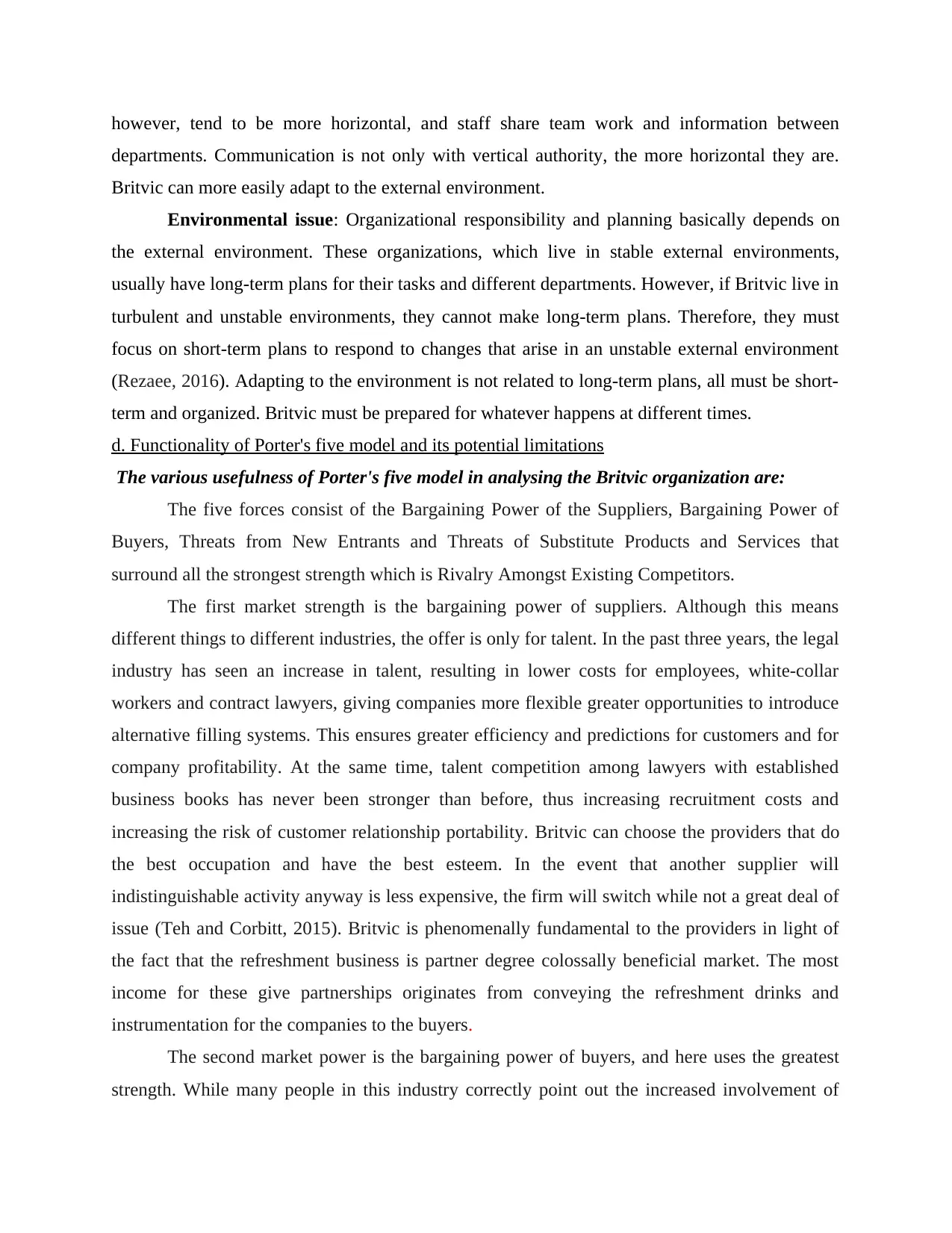
however, tend to be more horizontal, and staff share team work and information between
departments. Communication is not only with vertical authority, the more horizontal they are.
Britvic can more easily adapt to the external environment.
Environmental issue: Organizational responsibility and planning basically depends on
the external environment. These organizations, which live in stable external environments,
usually have long-term plans for their tasks and different departments. However, if Britvic live in
turbulent and unstable environments, they cannot make long-term plans. Therefore, they must
focus on short-term plans to respond to changes that arise in an unstable external environment
(Rezaee, 2016). Adapting to the environment is not related to long-term plans, all must be short-
term and organized. Britvic must be prepared for whatever happens at different times.
d. Functionality of Porter's five model and its potential limitations
The various usefulness of Porter's five model in analysing the Britvic organization are:
The five forces consist of the Bargaining Power of the Suppliers, Bargaining Power of
Buyers, Threats from New Entrants and Threats of Substitute Products and Services that
surround all the strongest strength which is Rivalry Amongst Existing Competitors.
The first market strength is the bargaining power of suppliers. Although this means
different things to different industries, the offer is only for talent. In the past three years, the legal
industry has seen an increase in talent, resulting in lower costs for employees, white-collar
workers and contract lawyers, giving companies more flexible greater opportunities to introduce
alternative filling systems. This ensures greater efficiency and predictions for customers and for
company profitability. At the same time, talent competition among lawyers with established
business books has never been stronger than before, thus increasing recruitment costs and
increasing the risk of customer relationship portability. Britvic can choose the providers that do
the best occupation and have the best esteem. In the event that another supplier will
indistinguishable activity anyway is less expensive, the firm will switch while not a great deal of
issue (Teh and Corbitt, 2015). Britvic is phenomenally fundamental to the providers in light of
the fact that the refreshment business is partner degree colossally beneficial market. The most
income for these give partnerships originates from conveying the refreshment drinks and
instrumentation for the companies to the buyers.
The second market power is the bargaining power of buyers, and here uses the greatest
strength. While many people in this industry correctly point out the increased involvement of
departments. Communication is not only with vertical authority, the more horizontal they are.
Britvic can more easily adapt to the external environment.
Environmental issue: Organizational responsibility and planning basically depends on
the external environment. These organizations, which live in stable external environments,
usually have long-term plans for their tasks and different departments. However, if Britvic live in
turbulent and unstable environments, they cannot make long-term plans. Therefore, they must
focus on short-term plans to respond to changes that arise in an unstable external environment
(Rezaee, 2016). Adapting to the environment is not related to long-term plans, all must be short-
term and organized. Britvic must be prepared for whatever happens at different times.
d. Functionality of Porter's five model and its potential limitations
The various usefulness of Porter's five model in analysing the Britvic organization are:
The five forces consist of the Bargaining Power of the Suppliers, Bargaining Power of
Buyers, Threats from New Entrants and Threats of Substitute Products and Services that
surround all the strongest strength which is Rivalry Amongst Existing Competitors.
The first market strength is the bargaining power of suppliers. Although this means
different things to different industries, the offer is only for talent. In the past three years, the legal
industry has seen an increase in talent, resulting in lower costs for employees, white-collar
workers and contract lawyers, giving companies more flexible greater opportunities to introduce
alternative filling systems. This ensures greater efficiency and predictions for customers and for
company profitability. At the same time, talent competition among lawyers with established
business books has never been stronger than before, thus increasing recruitment costs and
increasing the risk of customer relationship portability. Britvic can choose the providers that do
the best occupation and have the best esteem. In the event that another supplier will
indistinguishable activity anyway is less expensive, the firm will switch while not a great deal of
issue (Teh and Corbitt, 2015). Britvic is phenomenally fundamental to the providers in light of
the fact that the refreshment business is partner degree colossally beneficial market. The most
income for these give partnerships originates from conveying the refreshment drinks and
instrumentation for the companies to the buyers.
The second market power is the bargaining power of buyers, and here uses the greatest
strength. While many people in this industry correctly point out the increased involvement of
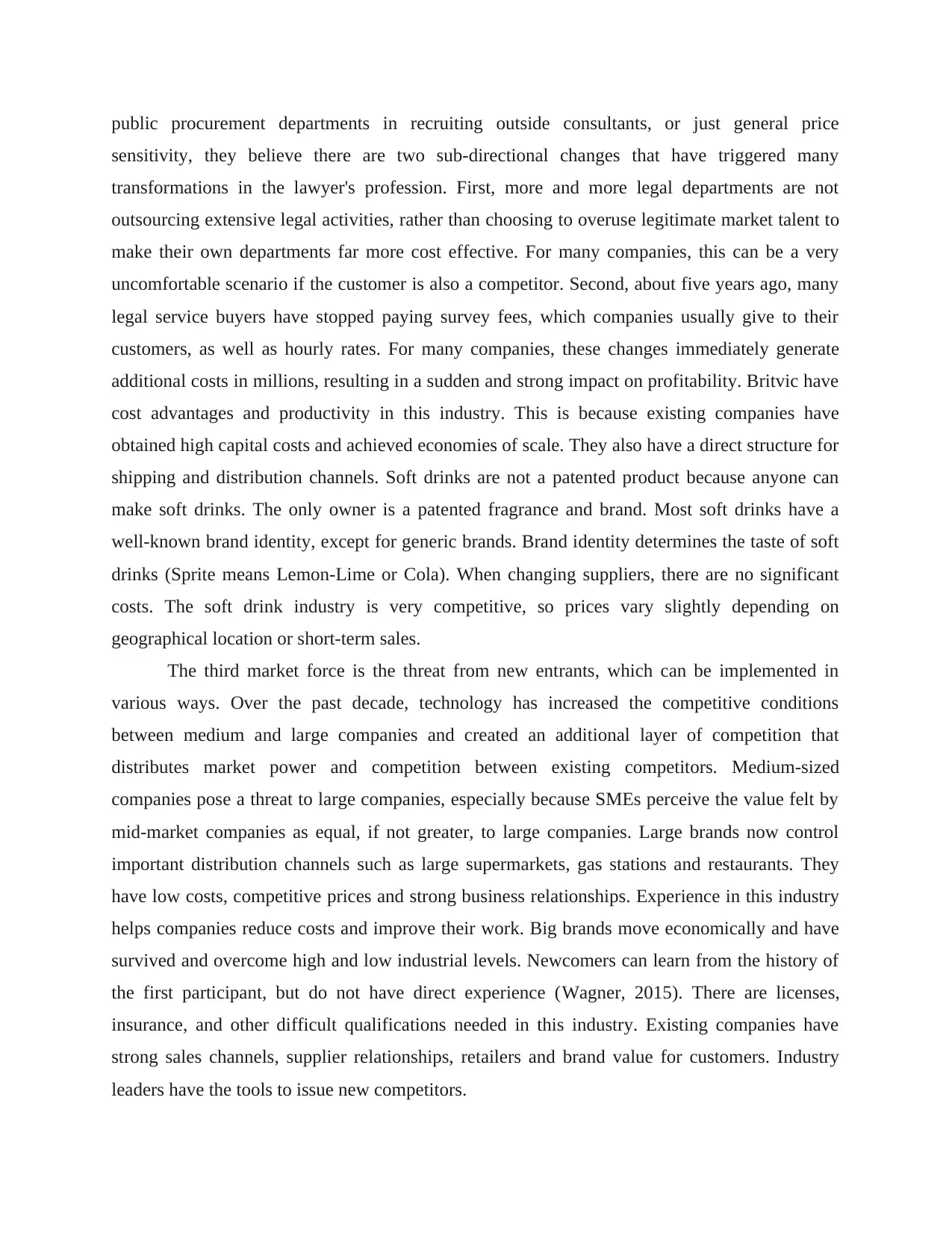
public procurement departments in recruiting outside consultants, or just general price
sensitivity, they believe there are two sub-directional changes that have triggered many
transformations in the lawyer's profession. First, more and more legal departments are not
outsourcing extensive legal activities, rather than choosing to overuse legitimate market talent to
make their own departments far more cost effective. For many companies, this can be a very
uncomfortable scenario if the customer is also a competitor. Second, about five years ago, many
legal service buyers have stopped paying survey fees, which companies usually give to their
customers, as well as hourly rates. For many companies, these changes immediately generate
additional costs in millions, resulting in a sudden and strong impact on profitability. Britvic have
cost advantages and productivity in this industry. This is because existing companies have
obtained high capital costs and achieved economies of scale. They also have a direct structure for
shipping and distribution channels. Soft drinks are not a patented product because anyone can
make soft drinks. The only owner is a patented fragrance and brand. Most soft drinks have a
well-known brand identity, except for generic brands. Brand identity determines the taste of soft
drinks (Sprite means Lemon-Lime or Cola). When changing suppliers, there are no significant
costs. The soft drink industry is very competitive, so prices vary slightly depending on
geographical location or short-term sales.
The third market force is the threat from new entrants, which can be implemented in
various ways. Over the past decade, technology has increased the competitive conditions
between medium and large companies and created an additional layer of competition that
distributes market power and competition between existing competitors. Medium-sized
companies pose a threat to large companies, especially because SMEs perceive the value felt by
mid-market companies as equal, if not greater, to large companies. Large brands now control
important distribution channels such as large supermarkets, gas stations and restaurants. They
have low costs, competitive prices and strong business relationships. Experience in this industry
helps companies reduce costs and improve their work. Big brands move economically and have
survived and overcome high and low industrial levels. Newcomers can learn from the history of
the first participant, but do not have direct experience (Wagner, 2015). There are licenses,
insurance, and other difficult qualifications needed in this industry. Existing companies have
strong sales channels, supplier relationships, retailers and brand value for customers. Industry
leaders have the tools to issue new competitors.
sensitivity, they believe there are two sub-directional changes that have triggered many
transformations in the lawyer's profession. First, more and more legal departments are not
outsourcing extensive legal activities, rather than choosing to overuse legitimate market talent to
make their own departments far more cost effective. For many companies, this can be a very
uncomfortable scenario if the customer is also a competitor. Second, about five years ago, many
legal service buyers have stopped paying survey fees, which companies usually give to their
customers, as well as hourly rates. For many companies, these changes immediately generate
additional costs in millions, resulting in a sudden and strong impact on profitability. Britvic have
cost advantages and productivity in this industry. This is because existing companies have
obtained high capital costs and achieved economies of scale. They also have a direct structure for
shipping and distribution channels. Soft drinks are not a patented product because anyone can
make soft drinks. The only owner is a patented fragrance and brand. Most soft drinks have a
well-known brand identity, except for generic brands. Brand identity determines the taste of soft
drinks (Sprite means Lemon-Lime or Cola). When changing suppliers, there are no significant
costs. The soft drink industry is very competitive, so prices vary slightly depending on
geographical location or short-term sales.
The third market force is the threat from new entrants, which can be implemented in
various ways. Over the past decade, technology has increased the competitive conditions
between medium and large companies and created an additional layer of competition that
distributes market power and competition between existing competitors. Medium-sized
companies pose a threat to large companies, especially because SMEs perceive the value felt by
mid-market companies as equal, if not greater, to large companies. Large brands now control
important distribution channels such as large supermarkets, gas stations and restaurants. They
have low costs, competitive prices and strong business relationships. Experience in this industry
helps companies reduce costs and improve their work. Big brands move economically and have
survived and overcome high and low industrial levels. Newcomers can learn from the history of
the first participant, but do not have direct experience (Wagner, 2015). There are licenses,
insurance, and other difficult qualifications needed in this industry. Existing companies have
strong sales channels, supplier relationships, retailers and brand value for customers. Industry
leaders have the tools to issue new competitors.
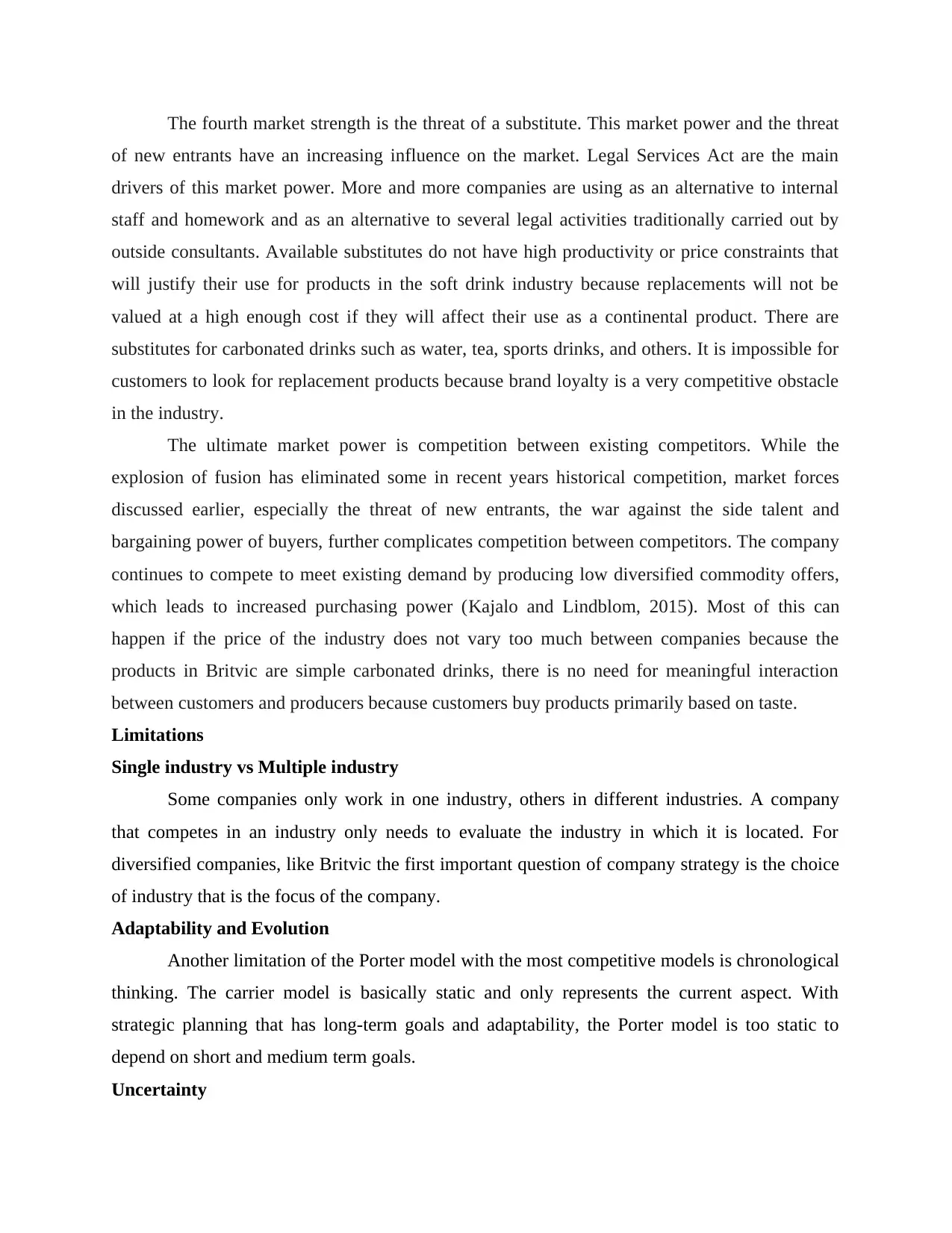
The fourth market strength is the threat of a substitute. This market power and the threat
of new entrants have an increasing influence on the market. Legal Services Act are the main
drivers of this market power. More and more companies are using as an alternative to internal
staff and homework and as an alternative to several legal activities traditionally carried out by
outside consultants. Available substitutes do not have high productivity or price constraints that
will justify their use for products in the soft drink industry because replacements will not be
valued at a high enough cost if they will affect their use as a continental product. There are
substitutes for carbonated drinks such as water, tea, sports drinks, and others. It is impossible for
customers to look for replacement products because brand loyalty is a very competitive obstacle
in the industry.
The ultimate market power is competition between existing competitors. While the
explosion of fusion has eliminated some in recent years historical competition, market forces
discussed earlier, especially the threat of new entrants, the war against the side talent and
bargaining power of buyers, further complicates competition between competitors. The company
continues to compete to meet existing demand by producing low diversified commodity offers,
which leads to increased purchasing power (Kajalo and Lindblom, 2015). Most of this can
happen if the price of the industry does not vary too much between companies because the
products in Britvic are simple carbonated drinks, there is no need for meaningful interaction
between customers and producers because customers buy products primarily based on taste.
Limitations
Single industry vs Multiple industry
Some companies only work in one industry, others in different industries. A company
that competes in an industry only needs to evaluate the industry in which it is located. For
diversified companies, like Britvic the first important question of company strategy is the choice
of industry that is the focus of the company.
Adaptability and Evolution
Another limitation of the Porter model with the most competitive models is chronological
thinking. The carrier model is basically static and only represents the current aspect. With
strategic planning that has long-term goals and adaptability, the Porter model is too static to
depend on short and medium term goals.
Uncertainty
of new entrants have an increasing influence on the market. Legal Services Act are the main
drivers of this market power. More and more companies are using as an alternative to internal
staff and homework and as an alternative to several legal activities traditionally carried out by
outside consultants. Available substitutes do not have high productivity or price constraints that
will justify their use for products in the soft drink industry because replacements will not be
valued at a high enough cost if they will affect their use as a continental product. There are
substitutes for carbonated drinks such as water, tea, sports drinks, and others. It is impossible for
customers to look for replacement products because brand loyalty is a very competitive obstacle
in the industry.
The ultimate market power is competition between existing competitors. While the
explosion of fusion has eliminated some in recent years historical competition, market forces
discussed earlier, especially the threat of new entrants, the war against the side talent and
bargaining power of buyers, further complicates competition between competitors. The company
continues to compete to meet existing demand by producing low diversified commodity offers,
which leads to increased purchasing power (Kajalo and Lindblom, 2015). Most of this can
happen if the price of the industry does not vary too much between companies because the
products in Britvic are simple carbonated drinks, there is no need for meaningful interaction
between customers and producers because customers buy products primarily based on taste.
Limitations
Single industry vs Multiple industry
Some companies only work in one industry, others in different industries. A company
that competes in an industry only needs to evaluate the industry in which it is located. For
diversified companies, like Britvic the first important question of company strategy is the choice
of industry that is the focus of the company.
Adaptability and Evolution
Another limitation of the Porter model with the most competitive models is chronological
thinking. The carrier model is basically static and only represents the current aspect. With
strategic planning that has long-term goals and adaptability, the Porter model is too static to
depend on short and medium term goals.
Uncertainty
Secure Best Marks with AI Grader
Need help grading? Try our AI Grader for instant feedback on your assignments.
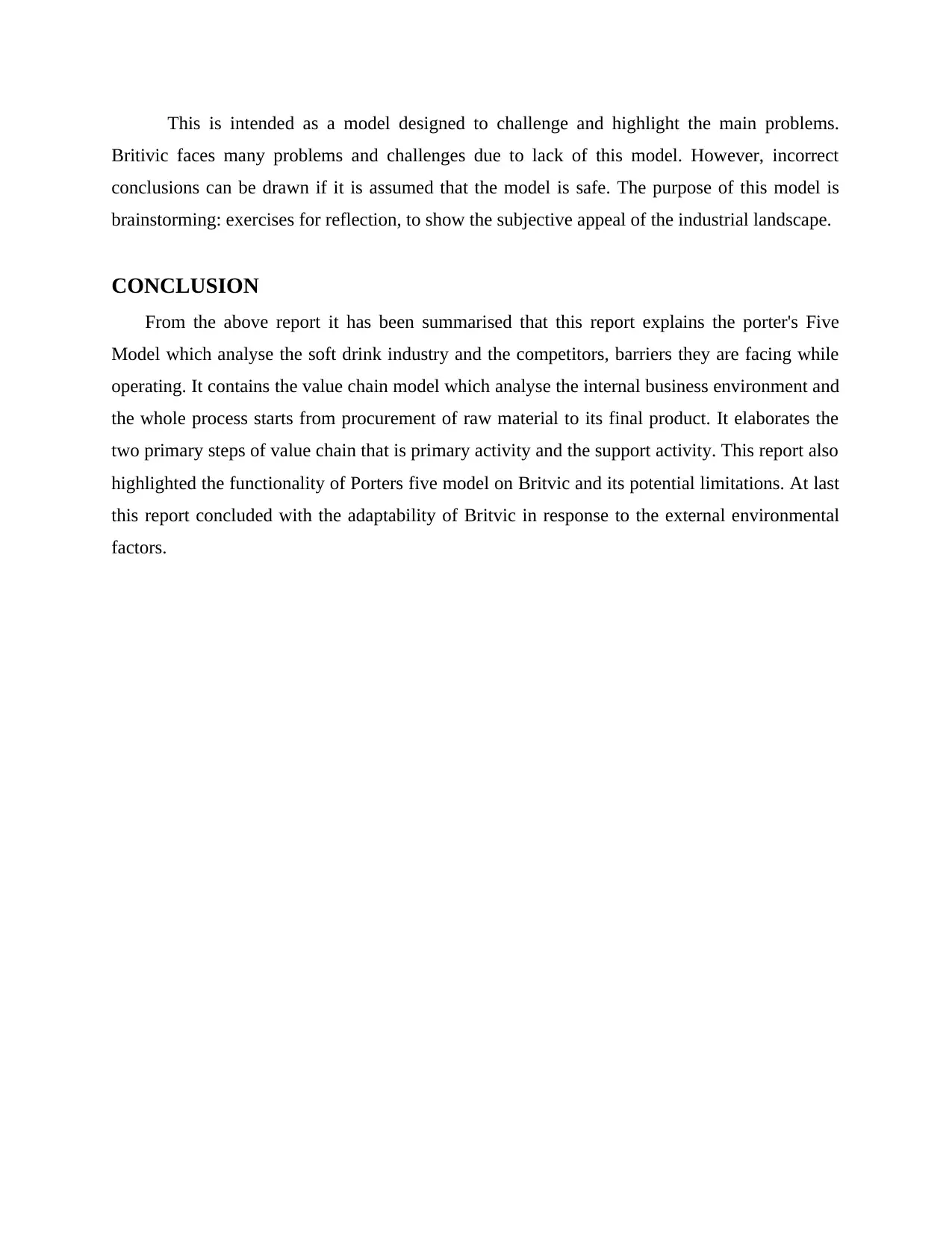
This is intended as a model designed to challenge and highlight the main problems.
Britivic faces many problems and challenges due to lack of this model. However, incorrect
conclusions can be drawn if it is assumed that the model is safe. The purpose of this model is
brainstorming: exercises for reflection, to show the subjective appeal of the industrial landscape.
CONCLUSION
From the above report it has been summarised that this report explains the porter's Five
Model which analyse the soft drink industry and the competitors, barriers they are facing while
operating. It contains the value chain model which analyse the internal business environment and
the whole process starts from procurement of raw material to its final product. It elaborates the
two primary steps of value chain that is primary activity and the support activity. This report also
highlighted the functionality of Porters five model on Britvic and its potential limitations. At last
this report concluded with the adaptability of Britvic in response to the external environmental
factors.
Britivic faces many problems and challenges due to lack of this model. However, incorrect
conclusions can be drawn if it is assumed that the model is safe. The purpose of this model is
brainstorming: exercises for reflection, to show the subjective appeal of the industrial landscape.
CONCLUSION
From the above report it has been summarised that this report explains the porter's Five
Model which analyse the soft drink industry and the competitors, barriers they are facing while
operating. It contains the value chain model which analyse the internal business environment and
the whole process starts from procurement of raw material to its final product. It elaborates the
two primary steps of value chain that is primary activity and the support activity. This report also
highlighted the functionality of Porters five model on Britvic and its potential limitations. At last
this report concluded with the adaptability of Britvic in response to the external environmental
factors.
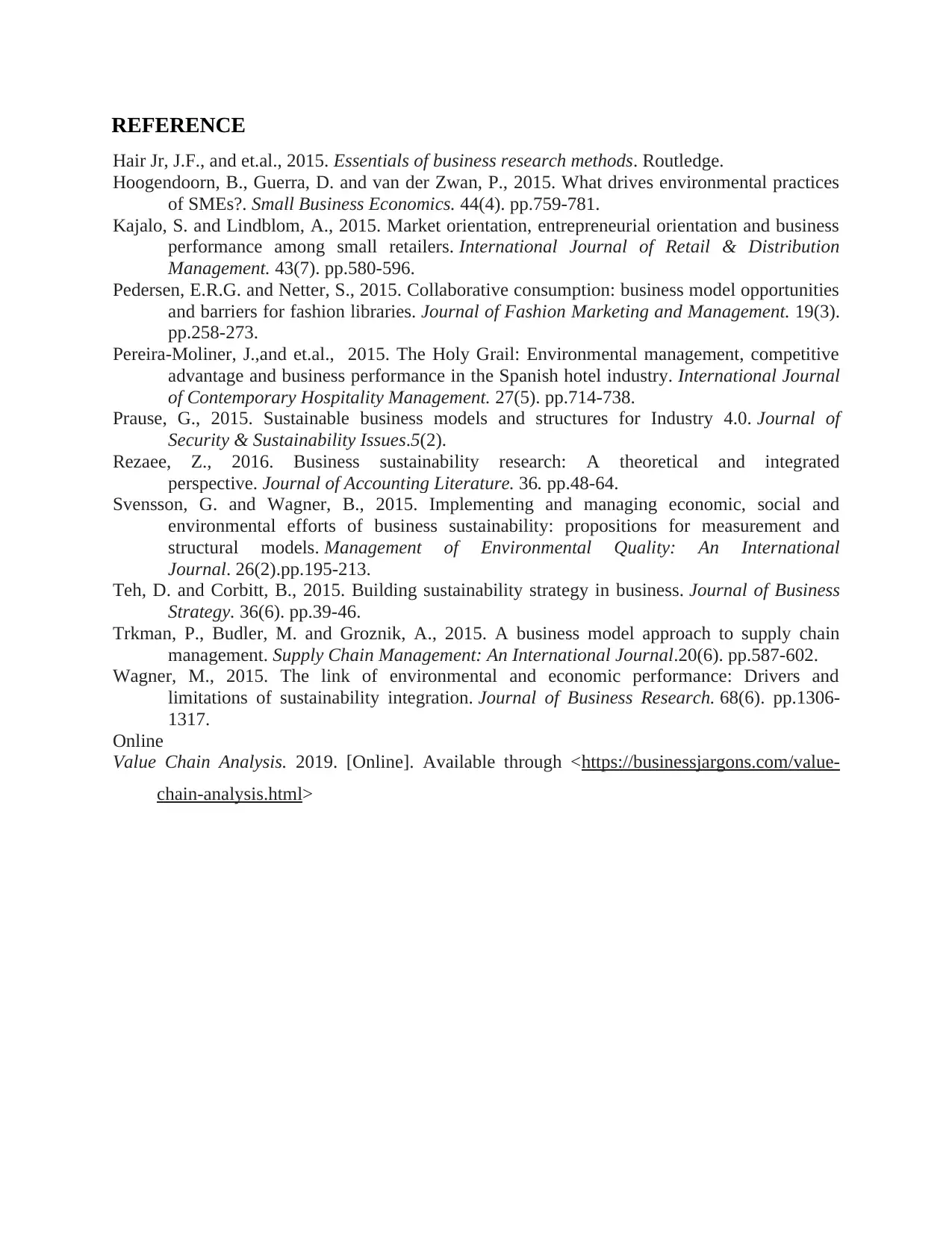
REFERENCE
Hair Jr, J.F., and et.al., 2015. Essentials of business research methods. Routledge.
Hoogendoorn, B., Guerra, D. and van der Zwan, P., 2015. What drives environmental practices
of SMEs?. Small Business Economics. 44(4). pp.759-781.
Kajalo, S. and Lindblom, A., 2015. Market orientation, entrepreneurial orientation and business
performance among small retailers. International Journal of Retail & Distribution
Management. 43(7). pp.580-596.
Pedersen, E.R.G. and Netter, S., 2015. Collaborative consumption: business model opportunities
and barriers for fashion libraries. Journal of Fashion Marketing and Management. 19(3).
pp.258-273.
Pereira-Moliner, J.,and et.al., 2015. The Holy Grail: Environmental management, competitive
advantage and business performance in the Spanish hotel industry. International Journal
of Contemporary Hospitality Management. 27(5). pp.714-738.
Prause, G., 2015. Sustainable business models and structures for Industry 4.0. Journal of
Security & Sustainability Issues.5(2).
Rezaee, Z., 2016. Business sustainability research: A theoretical and integrated
perspective. Journal of Accounting Literature. 36. pp.48-64.
Svensson, G. and Wagner, B., 2015. Implementing and managing economic, social and
environmental efforts of business sustainability: propositions for measurement and
structural models. Management of Environmental Quality: An International
Journal. 26(2).pp.195-213.
Teh, D. and Corbitt, B., 2015. Building sustainability strategy in business. Journal of Business
Strategy. 36(6). pp.39-46.
Trkman, P., Budler, M. and Groznik, A., 2015. A business model approach to supply chain
management. Supply Chain Management: An International Journal.20(6). pp.587-602.
Wagner, M., 2015. The link of environmental and economic performance: Drivers and
limitations of sustainability integration. Journal of Business Research. 68(6). pp.1306-
1317.
Online
Value Chain Analysis. 2019. [Online]. Available through <https://businessjargons.com/value-
chain-analysis.html>
Hair Jr, J.F., and et.al., 2015. Essentials of business research methods. Routledge.
Hoogendoorn, B., Guerra, D. and van der Zwan, P., 2015. What drives environmental practices
of SMEs?. Small Business Economics. 44(4). pp.759-781.
Kajalo, S. and Lindblom, A., 2015. Market orientation, entrepreneurial orientation and business
performance among small retailers. International Journal of Retail & Distribution
Management. 43(7). pp.580-596.
Pedersen, E.R.G. and Netter, S., 2015. Collaborative consumption: business model opportunities
and barriers for fashion libraries. Journal of Fashion Marketing and Management. 19(3).
pp.258-273.
Pereira-Moliner, J.,and et.al., 2015. The Holy Grail: Environmental management, competitive
advantage and business performance in the Spanish hotel industry. International Journal
of Contemporary Hospitality Management. 27(5). pp.714-738.
Prause, G., 2015. Sustainable business models and structures for Industry 4.0. Journal of
Security & Sustainability Issues.5(2).
Rezaee, Z., 2016. Business sustainability research: A theoretical and integrated
perspective. Journal of Accounting Literature. 36. pp.48-64.
Svensson, G. and Wagner, B., 2015. Implementing and managing economic, social and
environmental efforts of business sustainability: propositions for measurement and
structural models. Management of Environmental Quality: An International
Journal. 26(2).pp.195-213.
Teh, D. and Corbitt, B., 2015. Building sustainability strategy in business. Journal of Business
Strategy. 36(6). pp.39-46.
Trkman, P., Budler, M. and Groznik, A., 2015. A business model approach to supply chain
management. Supply Chain Management: An International Journal.20(6). pp.587-602.
Wagner, M., 2015. The link of environmental and economic performance: Drivers and
limitations of sustainability integration. Journal of Business Research. 68(6). pp.1306-
1317.
Online
Value Chain Analysis. 2019. [Online]. Available through <https://businessjargons.com/value-
chain-analysis.html>
1 out of 12
Related Documents
Your All-in-One AI-Powered Toolkit for Academic Success.
+13062052269
info@desklib.com
Available 24*7 on WhatsApp / Email
![[object Object]](/_next/static/media/star-bottom.7253800d.svg)
Unlock your academic potential
© 2024 | Zucol Services PVT LTD | All rights reserved.





